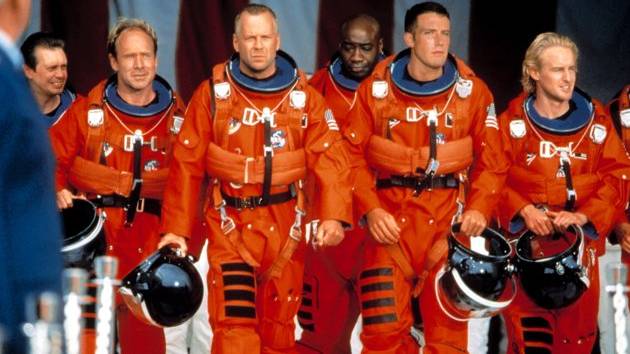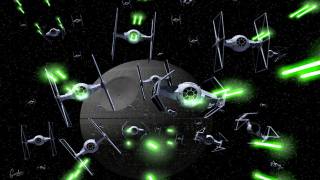Nukes in Space to Deal with Dangerous Asteroids?
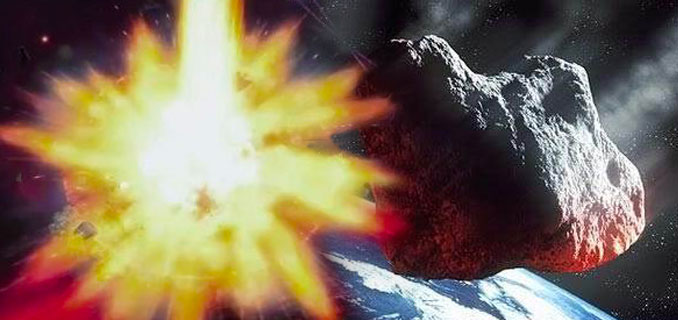
Nuclear one-two punch could knock out dangerous asteroid
From: msnbc.msn.com
Destroying a dangerous asteroid with a nuclear bomb is a well-worn trope of science fiction, but it could become reality soon enough.
Scientists are developing a mission concept that would blow apart an Earth-threatening asteroid with a nuclear explosion, just like Bruce Willis and his oilmen-turned-astronaut crew did in the 1998 film "Armageddon."
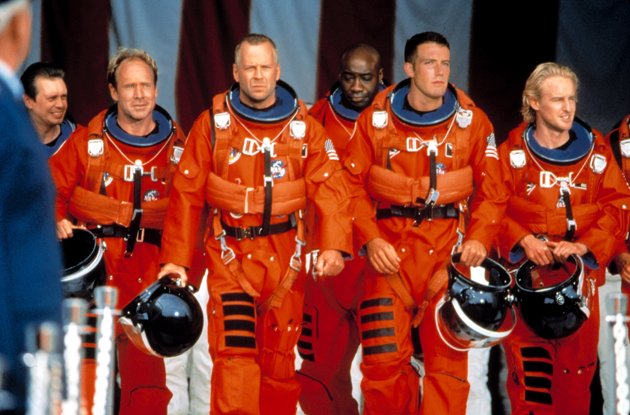
But unlike in the movie, the spacecraft under development — known as the Hypervelocity Asteroid Intercept Vehicle, or HAIV — would be unmanned. It would hit the space rock twice in quick succession, with the non-nuclear first blow blasting out a crater for the nuclear bomb to explode inside, thus magnifying its asteroid-shattering power.
"Using our proposed concept, we do have a practically viable solution — a cost-effective, economically viable, technically feasible solution," study leader Bong Wie, of Iowa State University, said Wednesday at the 2012 NASA Innovative Advanced Concepts (NIAC) meeting in Virginia.
When, not if
Earth has been pummeled by asteroids throughout its 4.5 billion-year history, and some of the strikes have been catastrophic. For example, a 6-mile-wide (10 kilometers) space rock slammed into the planet 65 million years ago, wiping out the dinosaurs.
Earth is bound to be hit again, and relatively soon. Asteroids big enough to cause serious damage today — not necessarily the extinction of humans, but major disruptions to the global economy — have hit the planet on average every 200 to 300 years, researchers say.
So humanity needs to have a plan in hand to deal with the next threatening asteroid, many scientists stress.
That plan should include deflection strategies, they say. Given a few decades of lead time, a threatening space rock could be nudged off course — perhaps by employing a tag-along "gravity tractor" probe, or even by painting the asteroid white and letting sunlight give it a push.
But humanity also needs to be prepared for an asteroid that pops up on scientists’ radar just weeks before a potential impact. That scenario might demand the nuclear option that Wie and his colleagues are working to develop.
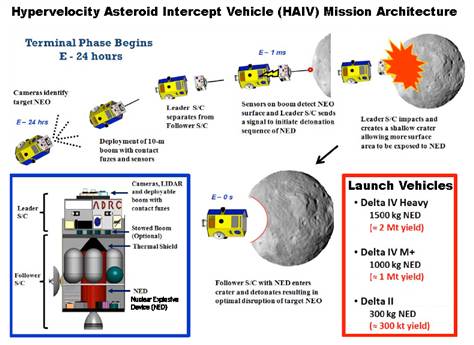
This diagram shows a mission concept that would destroy an asteroid with a nuclear bomb, which would detonate in a crater blasted out by a smaller impactor.
A one-two punch
NASA engineers identified 168 technical flaws in "Armageddon," Wie said. But one thing the movie got right is the notion that a nuke will be far more effective if it explodes inside an asteroid rather than at its surface. (At a depth of 10 feet, or 3 meters, the bomb’s destructive power would be about 20 times greater, Wie said.)
[...]
Read the full article at: msnbc.msn.com
NUCLEAR WEAPON EFFECTS IN SPACE (1957)
In addition to the natural radiation dangers which will confront the space traveler, we must also consider manmade perils which may exist during time of war. In particular, the use of nuclear weapons may pose a serious problem to manned military space operations. The singular emergence of man as the most vulnerable component of a space-weapon system becomes dramatically apparent when nuclear weapon effects in space are contrasted with the effects which occur within the Earth’s atmosphere.
When a nuclear weapon is detonated close to the Earth’s surface the density of the air is sufficient to attenuate nuclear radiation (neutrons and gamma rays) to such a degree that the effects of these radiations are generally less important than the effects of blast and thermal radiation. The relative magnitudes of blast, thermal and nuclear radiation effects are shown in figure 1 for a nominal fission weapon (20 kilotons) at sea level.1
If a nuclear weapon is exploded in a vacuum-i. e., in space-the complexion of weapon effects changes drastically:
First, in the absence of an atmosphere, blast disappears completely.
Second, thermal radiation, as usually defined, also disappears. There is no longer any air for the blast wave to heat and much higher frequency radiation is emitted from the weapon itself.
Third, in the absence of the atmosphere, nuclear radiation will suffer no physical attenuation and the only degradation in intensity will arise from reduction with distance. As a result the range of significant dosages will be many times greater than is the case at sea level.
Figure 2 shows the dosage-distance relationship for a 20-kiloton explosion when the burst takes place at sea level and when the burst takes place in space. We see that in the range 500 to 5,000 roentgens the space radii are of the order of 8 to 17 times as large as the sea-level radii. At lower dosages the difference between the two cases becomes even larger.
On August 1 and 12, 1958, nuclear warheads were detonated in missiles over Johnston Island in the Pacific.2 3 These detonations were accompanied by impressive visual displays seen over wide areas, leading observers to the opinion that the detonations took place at very high altitudes.4-7 These displays were even seen on Samoa, some 2,000 miles from Johnston Island.
The visual displays were accompanied by disruptive effects on radio communications. Specifically, most commercial communication systems operating on the high-frequency (about 5 to 25 megacycles) bands in the Pacific noted substantial disturbances. Most links within a few hundred miles of Johnston Island experienced "outages" for as long as several hours, at various times over a period of about a day. In general, the effects on high-frequency communication links appear to have been quite similar to the effects produced by giant solar flares.
Starfish Prime was a high-altitude nuclear test conducted by the United States of America on July 9, 1962, a joint effort of the Atomic Energy Commission (AEC) and the Defense Atomic Support Agency (which became the Defense Nuclear Agency in 1971).
Launched via a Thor rocket and carrying a W49 thermonuclear warhead (manufactured by Los Alamos Scientific Laboratory) and a Mk. 2 reentry vehicle, the explosion took place 250 miles (400 km) above a point 19 miles (31 km) southwest of Johnston Island in the Pacific Ocean. It was one of five tests conducted by the USA in outer space as defined by the FAI. It produced a yield equivalent to 1.4 megatons of TNT. (Source: Wikipedia)
Nuclear test "Starfish Prime’ through thin cloud, as seen from Honolulu. July 9, 1962
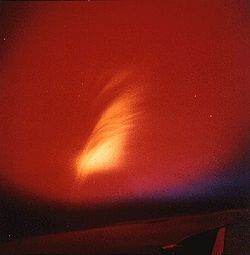
The debris fireball stretching along Earth’s magnetic field with air-glow aurora as seen at 3 minutes from an RC-135 surveillance aircraft.
AfterEffects:
While some of the energetic beta particles followed the Earth’s magnetic field and illuminated the sky, other high-energy electrons became trapped and formed radiation belts around the earth. There was much uncertainty and debate about the composition, magnitude and potential adverse effects from this trapped radiation after the detonation. The weaponeers became quite worried when three satellites in low earth orbit were disabled. These man-made radiation belts eventually crippled one-third of all satellites in low earth orbit. Seven satellites failed over the months following the test as radiation damaged their solar arrays or electronics, including the first commercial relay communication satellite, Telstar.[12][13][14] Detectors on Telstar, TRAAC, Injun, and Ariel 1 were used to measure distribution of the radiation produced by the tests.[15]
In 1963, Brown et al. reported in the Journal of Geophysical Research that Starfish Prime had created a belt of MeV electrons,[16] and Wilmot Hess reported in 1968 that some Starfish electrons remained for five years. (Source: Wikipedia)
Conventional Space Weapons
The fireball and blast wave is why nuclear warheads detonating in the atmosphere will flatten buildings for tens of kilometers, but detonations in space have a damage range under one kilometer.
If you want to get more bang for your buck, there is a possibility of making nuclear shaped charges. Instead of wasting their blast on a spherical surface, it can be directed at the target spacecraft. This will reduce the surface area of the blast, thus increasing the value for kiloJoules per square meter.
According to John Schilling, with current technology, the smallest nuclear warhead would probably be under a kiloton, and mass about twenty kilograms. A one-megaton warhead would be about a metric ton, though that could be reduced by about half with advanced technology.
Eric Rozier has an on-line calculator for nuclear weapons. Eric Henry has a spreadsheet that does nuclear blast calculations, including shaped charges, on his website.. For bomb blasts on the surface of the Earth or other planet with an atmosphere, you can use the handy-dandy Nuclear Bomb Effects Computer, found online here.
Back in the 1960’s, rocket scientist came up with the infamous "Orion Drive." This was basically a firecracker under a tin can. Except the tin can is a spacecraft, and the firecracker is a nuclear warhead.
Anyway, they realized that about 90% of the nuclear energy of an unmodified nuclear device would be wasted. The blast is radiated isotropically, only a small amount actually hits the pusher-plate and does useful work. So they tried to figure out how to channel all the blast in the desired direction. A nuclear shaped charge.
Remember that in the vacuum of space, most of the energy of a nuclear warhead is in the form of x-rays. The nuclear device is encased in a radiation case of x-ray opaque material (uranium) with a hole in the top. This forces the x-rays to to exit only from the hole. Where they run full tilt into a large mass of beryllium oxide (channel filler). The beryllium transforms the nuclear fury of x-rays into a nuclear fury of heat. Perched on top of the beryllium is the propellant: a thick plate of tungsten. The blast of heat turns the tungsten plate into a star-core-hot spindle-shaped-plume of ionized tungsten plasma. The x-ray opaque material and the beryllium oxide also vaporize a few microseconds later, but that’s OK, their job is done. The tungsten plasma jet hits square on the Orion drive pusher plate. With the reference design of nuclear pulse unit, the plume is confined to a cone of about 22.5 degrees. About 85% of the nuclear device’s energy is directed into the desired direction, which I think you’d agree is a vast improvement over 10%.
About this time the representatives of the military (who were funding this project) noticed that if you could make the plume a little faster and with a narrower cone, it would no longer be a propulsion system component. It would be a directed energy weapon.
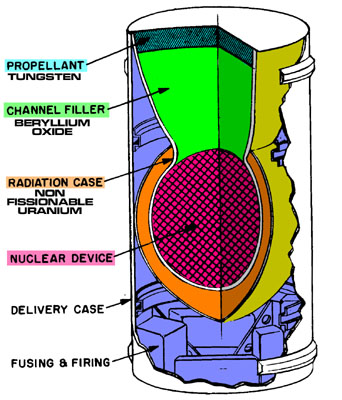
Tune into Red Ice Radio:
Randall Carlson - Hour 1 - Cycles of Catastrophe & Cosmic Patterns
Courtney Brown - Hour 2 - 2013 Timelines & Anomalies
Lucus - The Destroyer Star & The Future of Mankind
Richard C. Hoagland - The Secret Space Program & The Fukushima Nuclear Reactor Disaster
Matthew Stein - Hour 2 - 400 Chernobyls, Super Solar Storms & EMPs
Alfred Webre - Exopolitics, NASA Bombing of the Moon, Outer Space Treaty & E.T.
Mike Bara - Dark Mission, The Occult NASA Moon Mission
